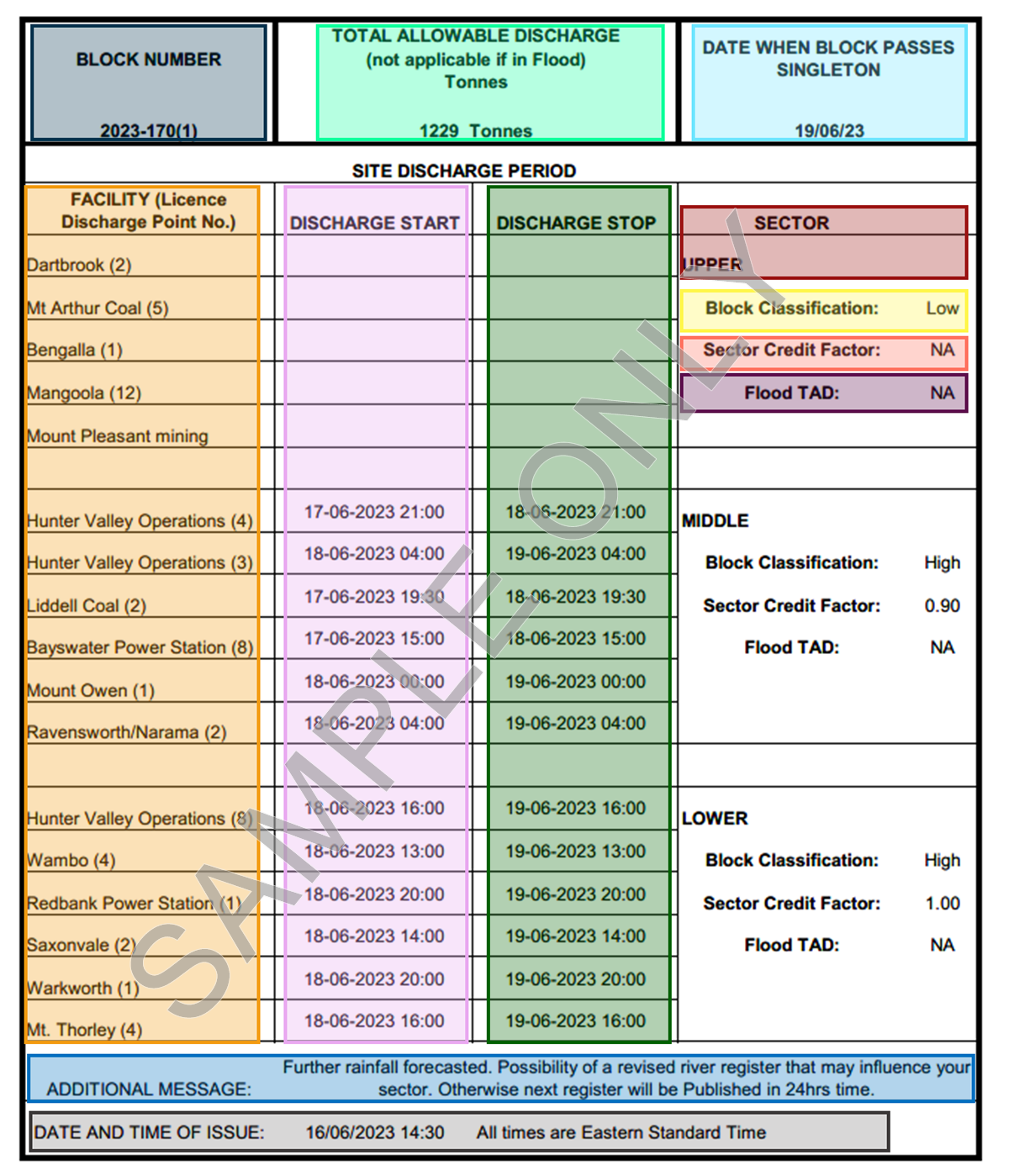River register
Participants in the Hunter River Salinity Trading Scheme (HRSTS) must discharge only when a river register has been issued for a given river block, under Clause 20 of the HRSTS Regulation.
A river register will be issued by the HRSTS Services Coordinator, Water NSW, when a significant rainfall event occurs in the Hunter catchment or when water from an associated dam is released into the catchment, causing the flow of the water in the river to meet or exceed high or flood flow states in one or more of the river sectors. The river register for a particular river block may be reissued if the conditions and flow state changes for one or more of the river sectors.
This page displays an example of a river register. Each section of this sample river register has been shaded in a coloured box with a corresponding explanation section below the sample. Please note the below river register is a sample only and not a published river register.
| Block number | The 24-hour period the block of water moves down the Hunter River, written in Julian Calendar format. |
| Total allowable discharge (TAD) | The maximum amount of salt which can be discharged into the Hunter River catchment during the current river block so that, taking into account the river flow and background (natural) salinity levels, the salinity target for the lower sector in relation to the river block is not exceeded. Measured in tonnes. Requires a high flow block. |
| Date when block passes Singleton | The date when the current river block will pass Singleton and therefore when the discharged water and salt will pass Singleton. |
| Facility | The scheme participant’s discharge facility name and discharge point number. |
| Discharge start | The date and time a facility/participant can commence discharging. If blank, the facility/participant cannot discharge. |
| Discharge stop | The date and time a facility/participant must cease discharging. If blank, the facility/participant should not have discharged. |
| Sector | Upper, Middle and Lower sectors of the Hunter River. |
| Block classification | Indicates the flow state of the river at the current river block. Low = no discharge opportunity, High or Flood = discharge opportunity available. |
| Sector credit factor | The credits held by each sector of the Hunter River entitle the sector to a percentage of the TAD. This percentage may exceed sector electrical conductivity (EC) targets if a higher number of credits are held in one sector. The sector credit factor is applied to reduce the discharge opportunity (% of TAD per credit) and keep the sector’s salt load below EC targets. (Note: EC is a measure of salinity in the river water). See Hunter River Salinity Trading Scheme Regulation 2002, Clause 23 for formula to calculate number of credits, where “D” is equal to the Sector Credit Factor for the river block at the start of the discharge. |
| Flood TAD | If the river flow is in Flood conditions, the TAD does not apply (NA). A maximum discharge volume limit still applies. This limit is the tributary protection limit specified on the participant’s discharge license that authorises them to discharge from their discharge point. See Hunter River Salinity Trading Scheme Regulation 2002, Clause 26. |
| Additional message | Communication of the likelihood of predicted rainfall and whether the current river register will be revised and reissued under changing rainfall and river flow conditions. |
| Date and time | The date and time the river register was sent to participants, in Australian Eastern Standard Time. |
